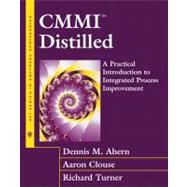
| Figure List | p. ix |
| Preface | p. xi |
| Integrated Process Improvement | p. 1 |
| Why Integrated Process Improvement? | p. 3 |
| The Engineering Environment of the Twenty-First Century | p. 5 |
| Concurrent Engineering and the Cross-Discipline Team | p. 7 |
| A Proliferation of Models and Standards | p. 8 |
| The Benefits of Integrated Process Improvement | p. 14 |
| Conclusions | p. 16 |
| Implementing Integrated Process Improvement | p. 19 |
| Starting Integrated Process Improvement | p. 20 |
| Building an Integrated Improvement Infrastructure | p. 24 |
| Integrating Legacy Processes and Initiatives | p. 25 |
| Using Assessments | p. 27 |
| Integrated Process Improvement Examples | p. 28 |
| The CMMI Models | p. 47 |
| The CMMI Concept | p. 49 |
| CMMI Project Organization | p. 50 |
| CMMI Objectives | p. 52 |
| The Three Source Models | p. 55 |
| Process Areas | p. 60 |
| An Extensible Framework | p. 63 |
| CMMI Content | p. 65 |
| Content Classification | p. 66 |
| Required Materials | p. 66 |
| Expected Materials | p. 69 |
| Informative Materials | p. 72 |
| Document Map | p. 75 |
| CMMI Representations | p. 79 |
| Staged Models | p. 80 |
| Continuous Models | p. 83 |
| CMMI Model Representations | p. 85 |
| CMMI Dimensions for Measuring Improvement | p. 95 |
| Capability Dimension | p. 96 |
| Maturity Dimension | p. 101 |
| Generic Practices in the Capability Dimension | p. 103 |
| Generic Practices in the Maturity Dimension | p. 110 |
| Organizational Capability Evolution | p. 112 |
| CMMI Process Areas | p. 115 |
| Process Management Process Areas | p. 117 |
| Project Management Process Areas | p. 124 |
| Engineering Process Areas | p. 132 |
| Support Process Areas | p. 143 |
| Integrated Product and Process Development Process Areas | p. 149 |
| Acquisition Process Areas | p. 152 |
| Relationships within CMMI Components | p. 155 |
| Using CMMI | p. 161 |
| Selecting the Appropriate Disciplines | p. 163 |
| The Discipline Dilemma | p. 164 |
| Your Situation | p. 164 |
| The IPPD Extension | p. 166 |
| The Acquisition Extension | p. 167 |
| Selecting the Appropriate Model | p. 169 |
| Picking a Representation | p. 171 |
| Reasons for Liking Staged Models | p. 172 |
| Reasons for Liking Continuous Models | p. 174 |
| Reasons for Choosing a CMMI Representation | p. 176 |
| Assessments with CMMI | p. 179 |
| Assessment Requirements for CMMI | p. 180 |
| Standard CMMI Assessment Method for Process Improvement | p. 183 |
| Using Assessments in Process Improvement | p. 185 |
| Making a CMMI Model Your Own (Tailoring) | p. 186 |
| The Future of CMMI | p. 191 |
| Evolving CMMI | p. 193 |
| Single versus Dual Representations | p. 194 |
| Collection of Issues for Version 1.1 and Beyond | p. 202 |
| Afterword | p. 207 |
| The Charge of the CMMI Product Team | p. 209 |
| Summary of CMMI-SE/SW/IPPD Models: Summary of Continuous Representation | p. 211 |
| Summary of CMMI-SE/SW/IPPD Models: Summary of Staged Representation | p. 231 |
| References | p. 275 |
| Resources | p. 279 |
| Index | p. 287 |
| Table of Contents provided by Syndetics. All Rights Reserved. |
The New copy of this book will include any supplemental materials advertised. Please check the title of the book to determine if it should include any access cards, study guides, lab manuals, CDs, etc.
The Used, Rental and eBook copies of this book are not guaranteed to include any supplemental materials. Typically, only the book itself is included. This is true even if the title states it includes any access cards, study guides, lab manuals, CDs, etc.